Human Phospho-Axl (Y779) Antibody Summary
Applications
Please Note: Optimal dilutions should be determined by each laboratory for each application. General Protocols are available in the Technical Information section on our website.
Scientific Data
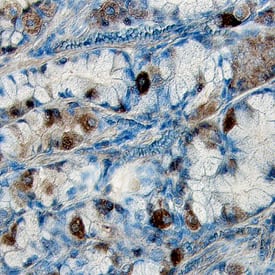 View Larger
View Larger
Phospho-Axl (Y779) in Human Stomach Cancer Tissue. Axl phosphorylated at site Y779 was detected in immersion fixed paraffin-embedded sections of human stomach cancer tissue using Human Phospho-Axl (Y779) Antigen Affinity-purified Polyclonal Antibody (Catalog # AF2228) at 15 µg/mL overnight at 4 °C. Tissue was stained using the Anti-Rabbit HRP-DAB Cell & Tissue Staining Kit (brown; CTS005) and counterstained with hematoxylin (blue). Specific labeling was localized to the cytoplasm of epithelial cells. View our protocol for Chromogenic IHC Staining of Paraffin-embedded Tissue Sections.
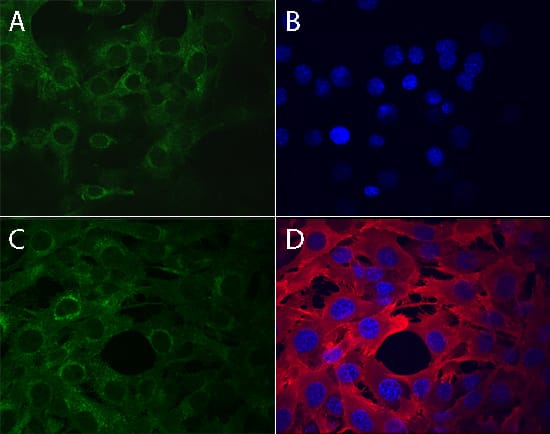 View Larger
View Larger
Phospho-Axl (Y779) in A172 Human Cell Line. Axl phosphorylated at Y779 (panels B, D) and total Axl (panels A, C) were assessed in immersion fixed A172 human glioblastoma cells incubated with (panels C, D) or without (panels A, B) pervanadate. Phospho-Axl was detected using Rabbit Anti-Human Phospho-Axl (Y779) Antigen Affinity-purified Polyclonal Antibody (Catalog # AF2228) at 10 µg/mL for 3 hours at room temperature. Cells were stained using the NorthernLights™ 557-conjugated Anti-Rabbit IgG Secondary Antibody (red, panels B, D); NL004) and counterstained using DAPI (blue). Total Axl was detected using Goat Anti-Human Axl Antigen Affinity-purified Polyclonal Antibody (AF154). Cells were stained using the NorthernLights™ 493-conjugated Anti-Goat IgG Secondary Antibody (green, panels A, C); NL003). Specific staining was localized to cytoplasm. View our protocol for Fluorescent ICC Staining of Cells on Coverslips.
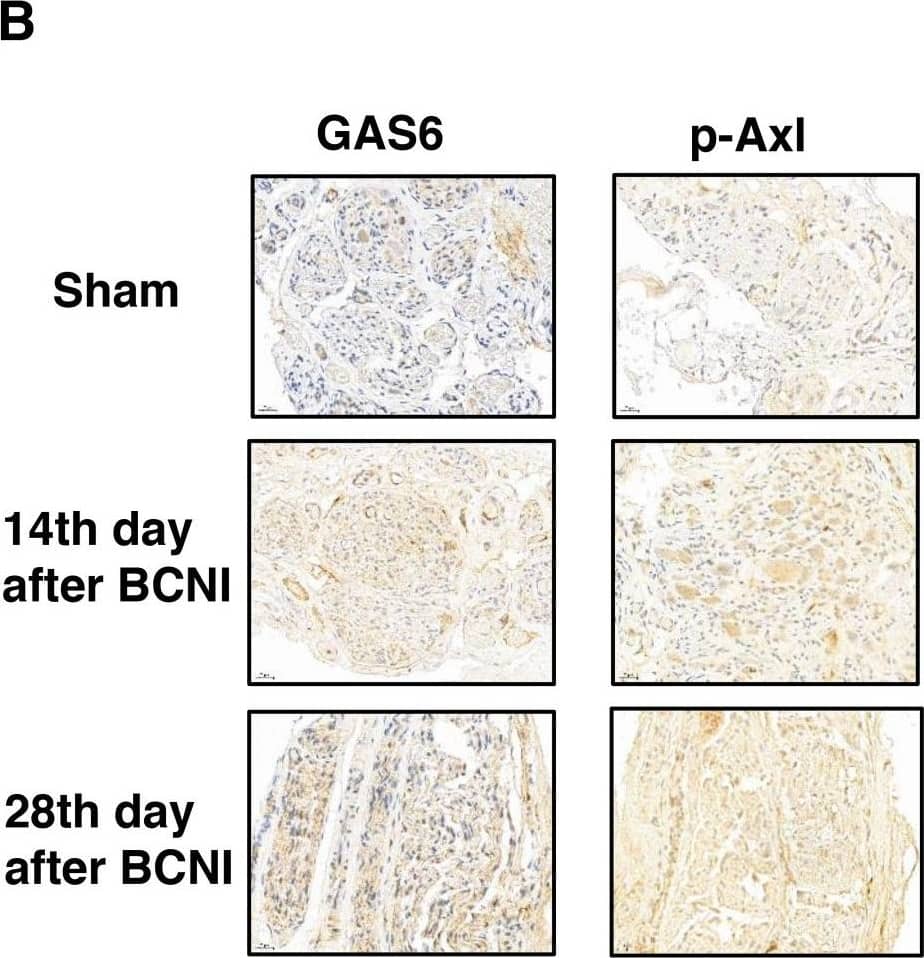 View Larger
View Larger
Detection of Rat Axl by Immunohistochemistry GAS6 and p-AXL are expressed in the regenerative cavernous nerve of rats subjected to BCNI(A) Representative ICP tracing responses of each group (n=5 per group) to the stimulation of the cavernous nerve at 14 days and 28 days. The green bar represents an electrical stimulus duration of 60 seconds. (B) Immunohistochemistry images demonstrated that GAS6 and p-AXL expression levels increased in the cavernous nerve after BCNI. (C) The quantitative analysis results showed a significantly higher expression of GAS6 and p-AXL in the cavernous nerve of animals subjected to injury after 28 days. Image collected and cropped by CiteAb from the following publication (https://www.oncotarget.com/lookup/doi/10.18632/oncotarget.23978), licensed under a CC-BY license. Not internally tested by R&D Systems.
 View Larger
View Larger
Detection of Rat Human Phospho-Axl (Y779) Antibody by Western Blot GAS6 triggered Schwann cell proliferation primarily through CIP2A and DAPK(A) RSC96 cells were transfected with either control or DAPK siRNA for 48 h and then exposed to GAS6 (100 ng/ml) for 30 min. Immunoblotting evaluations of pAxl, Axl, CIP2A, DAPK, pERK1/2, ERK1/2, pAKT, AKT, Myc and Survivin. (B) RSC96 cells were transfected with either control or CIP2A siRNA for 48 h and then exposed to GAS6 (100 ng/ml) for 30 min. Immunoblotting evaluations of pAxl, Axl, DAPK, pDAPK, pERK1/2, ERK1/2, pAKT, AKT, Myc and Survivin. (C) DAPK or CIP2A was knocked down for 48 h then RSC96 cells were incubated with GAS6 (100 ng/ml) at the indicated hours. Cell viability was analysed via the WST-1 assay. Data are the mean ± SD, and n = 3 for each time point. * p < 0.05, ** p < 0.01 vs. scramble. Image collected and cropped by CiteAb from the following publication (https://pubmed.ncbi.nlm.nih.gov/29464081), licensed under a CC-BY license. Not internally tested by R&D Systems.
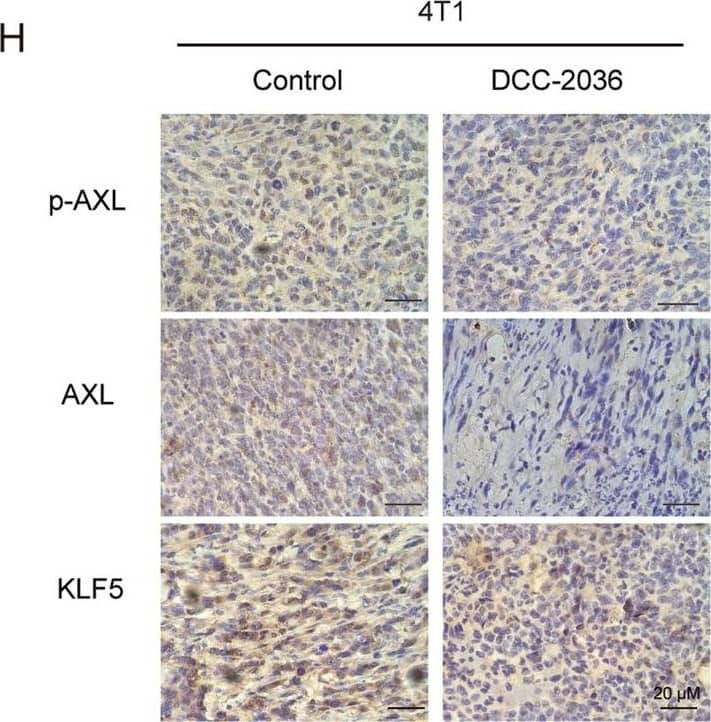 View Larger
View Larger
Detection of Human Axl by Immunohistochemistry DCC-2036 inhibits CSCs in vivo according to the limited dilution assay by pretreating 4T1 cells with DCC-2036 or DMSO for 48 h.A In vivo tumorigenicity assay with limited dilution using DMSO or DCC-2036 treated 4T1 cells respectively: 200,000 (n = 7 and 8), 20,000 (n = 9 and 8), or 2000 (n = 10 and 10) cells per injection site. The frequency of BCSCs was calculated by ELDA. B Weight variation of mice following transplant of 4T1 cells into BALB/C mice after 7 days. C Images of tumor formation in BALB/C mice. D, E Transplanted tumors were harvested, and the tumor size and weight were measured at the end of the experiment. The statistical significance was determined by Student’s t-test. F Tumor-free survival curve of BALB/C mice is shown. G Hematoxylin and eosin (H&E) staining indicates the histology of tumor tissues. Scale bars, 20 μm. H Immunohistochemical analysis using p-AXL, AXL, and KLF5 antibodies in xenograft tissues from BALB/C mice. Scale bars, 20 μm. I Immunoblot of transplanted tumors from BALB/C mice posterior to the experiments. C means Control, T means DCC-2036. We chose the tumor tissues randomly for H&E staining, immunohistochemical analysis, and immunoblotting. Image collected and cropped by CiteAb from the following open publication (https://pubmed.ncbi.nlm.nih.gov/36042208), licensed under a CC-BY license. Not internally tested by R&D Systems.
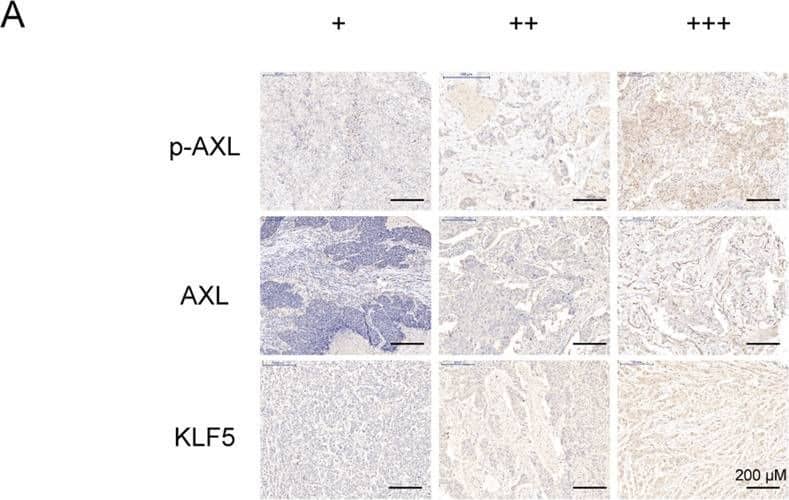 View Larger
View Larger
Detection of Human Axl by Immunohistochemistry The expression of p-AXL&AXL positively correlates with the expression of KLF5 in human TNBC specimens. Moreover, DCC-2036 increases the sensitivity of TNBC chemotherapy by decreasing BCSCs.A Representative immunohistochemical staining images of p-AXL, AXL,&KLF5 protein in TNBC specimens, in which the expression of p-AXL, AXL,&KLF5 proteins was indicated by mild positive (+), moderate positive (++),&strong positive (+++), respectively. Left: Scale bars, 200 μm (magnification 40×); Right: Scale bars, 50 μm (magnification 100×). Image collected & cropped by CiteAb from the following open publication (https://pubmed.ncbi.nlm.nih.gov/36042208), licensed under a CC-BY license. Not internally tested by R&D Systems.
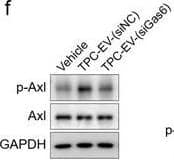 View Larger
View Larger
Detection of Human Axl by Western Blot TPC‐EV‐induced EPC vasculogenic properties are regulated by Gas6 in vitro. (f) The phosphorylated&total forms of Axl, Akt&Erk1/2 in EPCs after the indicated treatments determined. Representative blots&quantification of the ratio of p‐Axl/Axl (n = 3). TPC‐EV‐(siNC), EVs derived from TPCs transfected with NC siRNA. TPC‐EV‐(siGas6), EVs derived from TPCs transfected with Gas6 siRNA. Image collected & cropped by CiteAb from the following open publication (https://pubmed.ncbi.nlm.nih.gov/34035882), licensed under a CC-BY license. Not internally tested by R&D Systems.
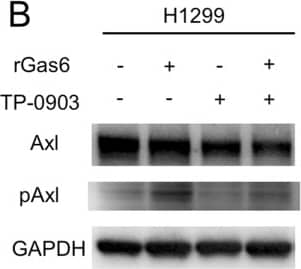 View Larger
View Larger
Detection of Human Axl by Western Blot Migration of H1299 NSCLC cells enhanced by ligand-dependent Axl activation. (A) Western blotting to assess Gas6 expression in H1299 cells. Expression of Gas6 in LCAFhTERT cells was used as a positive control. (B) Phosphorylation of Axl was analyzed by Western blotting of whole cell lysates using different antibodies. GAPDH was used as an internal control. H1299 cells were stimulated for 15 min with 400 nM recombinant human Gas6 (rGas6). H1299 cells were treated with or without TP-0903 (0.2 µmol/L) for 24 h. (C) Migration of H1299 cells was analyzed using rGas6 (400 nM) added to the lower chamber. H1299 cells were treated with or without TP-0903 (0.2 µmol/L) for 24 h. (D) Western blotting of conditioned medium from LCAFhTERT transfected with siGas6 or siScr (control) to assess whether they contains Gas6 secreted by CAFs. (E) Phosphorylation of Axl in H1299 cells analyzed by Western blotting after stimulation with conditioned medium from siRNA-transfected LCAFhTERT. H1299 cells were treated with or without TP-0903 (0.2 µmol/L) for 24 h. The medium (DMEM containing 10% FBS) was used as control. (F) Migration of H1299 cells analyzed using conditioned medium of siRNA-transfected LCAFhTERT. H1299 cells were treated with or without TP-0903 (0.2 µmol/L) for 24 h. The medium (DMEM containing 10% FBS) was used as control. The relative number of migrated H1299 cells is indicated on the y-axis. Data show the mean ± SEM (n = 3); **p < 0.01. Image collected and cropped by CiteAb from the following open publication (https://pubmed.ncbi.nlm.nih.gov/28878389), licensed under a CC-BY license. Not internally tested by R&D Systems.
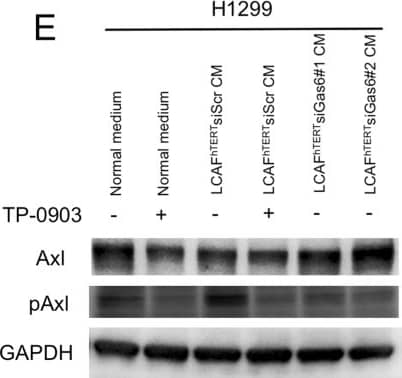 View Larger
View Larger
Detection of Human Axl by Western Blot Migration of H1299 NSCLC cells enhanced by ligand-dependent Axl activation. (A) Western blotting to assess Gas6 expression in H1299 cells. Expression of Gas6 in LCAFhTERT cells was used as a positive control. (B) Phosphorylation of Axl was analyzed by Western blotting of whole cell lysates using different antibodies. GAPDH was used as an internal control. H1299 cells were stimulated for 15 min with 400 nM recombinant human Gas6 (rGas6). H1299 cells were treated with or without TP-0903 (0.2 µmol/L) for 24 h. (C) Migration of H1299 cells was analyzed using rGas6 (400 nM) added to the lower chamber. H1299 cells were treated with or without TP-0903 (0.2 µmol/L) for 24 h. (D) Western blotting of conditioned medium from LCAFhTERT transfected with siGas6 or siScr (control) to assess whether they contains Gas6 secreted by CAFs. (E) Phosphorylation of Axl in H1299 cells analyzed by Western blotting after stimulation with conditioned medium from siRNA-transfected LCAFhTERT. H1299 cells were treated with or without TP-0903 (0.2 µmol/L) for 24 h. The medium (DMEM containing 10% FBS) was used as control. (F) Migration of H1299 cells analyzed using conditioned medium of siRNA-transfected LCAFhTERT. H1299 cells were treated with or without TP-0903 (0.2 µmol/L) for 24 h. The medium (DMEM containing 10% FBS) was used as control. The relative number of migrated H1299 cells is indicated on the y-axis. Data show the mean ± SEM (n = 3); **p < 0.01. Image collected and cropped by CiteAb from the following open publication (https://pubmed.ncbi.nlm.nih.gov/28878389), licensed under a CC-BY license. Not internally tested by R&D Systems.
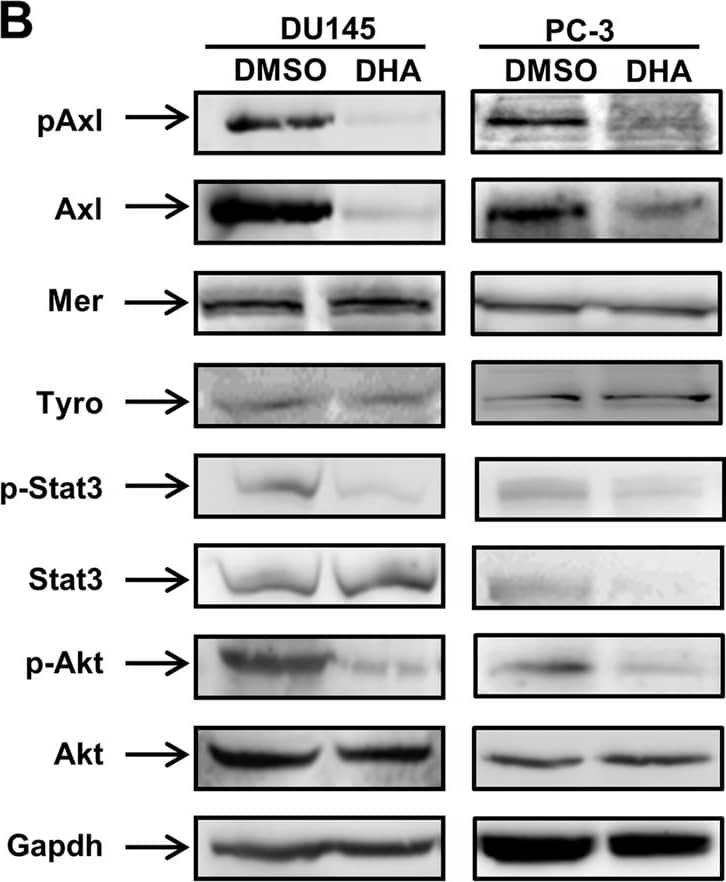 View Larger
View Larger
Detection of Human Axl by Western Blot DHA treatment inhibits Axl expression and proteins involved in the Axl signaling pathway, reduces cell migration and invasion and induces apoptosis in mCRPCa cell lines.a qRT-PCR for Axl in PCa cells treated with 5 μM of DHA for 24 h. Values were normalized to Gapdh levels and to DMSO control. The experiment was performed in triplicate. Data are representative of 3 independent experiments; *p < 0.05 two-tailed Student’s t-test. b Immunoblot analysis of protein extracts obtained from DU145 and PC-3 treated with 5 μM DHA for 24 h using anti-phospho-Axl, anti-phospho-Akt and anti-phospho-Stat3 and anti-Axl, anti-Akt, anti-Stat3 and anti- GAPDH. c Migration and d invasion analysis of mCRPC cell lines 24 h post treatment with 5 μM of DHA. Cells were fixed and stained, and 3–5 random microscopic fields were counted. Data are representative of three independent experiments and all values shown are mean ± SD from a representative experiment; **p < 0.01, two-tailed Student’s t-test. e Apoptosis assay for mCRPCa cell lines treated with 5 μM of DHA for 8 h. DMSO 0.05% was used as a control. Data are representative of three independent experiments and all values shown are mean ± SD from a representative experiment; *p < 0.05, two-tailed Student’s t-test Image collected and cropped by CiteAb from the following open publication (https://pubmed.ncbi.nlm.nih.gov/30783079), licensed under a CC-BY license. Not internally tested by R&D Systems.
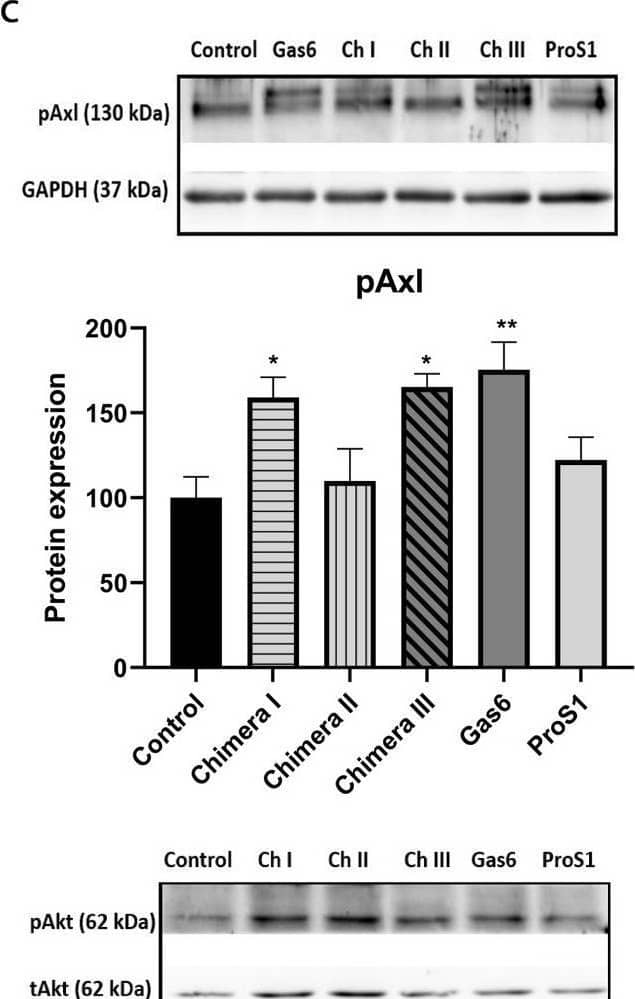 View Larger
View Larger
Detection of Phospho-Axl (Y779) by Western Blot The effects of ProS1, Gas6 and chimeras on TAM receptor and coupled downstream signalling molecule activation in SCC-25 cells. (a) Schematic representation of recombinant TAM ligand constructs used in this study. These included human ProS1, Gas6, and three ProS1/Gas6 chimeras. All of the chimeras contained the Gla domain and EGF-like domains of ProS1. Light grey colour denotes regions corresponding to ProS1 amino acid sequence, whereas dark grey denotes regions corresponding to Gas6 amino acid sequence. (b) Western blot showing phosphorylated Tyro3 (pTyro3) and Erk (pErk) levels after stimulation with recombinant Gas6, ProS1 and three chimeras (7.5 nM) for 9 min. (c) Western blot showing phosphorylated Axl (pAxl) and Akt (pAkt) levels under the same experimental conditions as in (b). Each representative blot image is followed by accompanying graphs of densitometric quantification of bands (n = 3 separate experiments). Data as mean ± SEM expression for each phosphoprotein was normalized against the total protein/loading control (tTyro3, tERK, GAPDH, actin). ANOVA with Tukey's multiple comparison post-hoc analysis; ***p < 0.001, **p < 0.01, *p < 0.05 versus control (untreated). While the sample loading order is different in the pAxl blot, the quantification bar charts are presented in the same order for consistency. Image collected and cropped by CiteAb from the following open publication (https://pubmed.ncbi.nlm.nih.gov/35518197), licensed under a CC-BY license. Not internally tested by R&D Systems.
Reconstitution Calculator
Preparation and Storage
- 12 months from date of receipt, -20 to -70 °C as supplied.
- 1 month, 2 to 8 °C under sterile conditions after reconstitution.
- 6 months, -20 to -70 °C under sterile conditions after reconstitution.
Background: Axl
Axl (Ufo, Ark), Dtk (Sky, Tyro3, Rse, Brt), and Mer (human and mouse homologues of chicken c-Eyk) constitute a subfamily of the receptor tyrosine kinases (1, 2). The extracellular domains of these proteins contain two Ig-like motifs and two fibronectin type III motifs. This characteristic topology is also found in neural cell adhesion molecules and in receptor tyrosine phosphatases. The human Axl cDNA encodes an 887 amino acid (aa) precursor that includes an 18 aa signal sequence, a 426 aa extracellular domain, a 21 aa transmembrane segment, and a 422 aa cytoplasmic domain. The extracellular domains of human and mouse Axl share 81% aa sequence identity. A short alternately spliced form of human Axl is distinguished by a 9 aa deletion in the extracellular juxtamembrane region. These receptors bind the vitamin K‑dependent protein growth arrest specific gene 6 (Gas6) which is structurally related to the anticoagulation factor protein S. Binding of Gas6 induces receptor autophosphorylation and downstream signaling pathways that can lead to cell proliferation, migration, or the prevention of apoptosis (3). This family of tyrosine kinase receptors is involved in hematopoiesis, embryonic development, tumorigenesis, and regulation of testicular functions.
- Yanagita, M. (2004) Curr. Opin. Nephrol. Hypertens. 13:465.
- Nagata, K. et al. (1996) J. Biol. Chem. 22:30022.
- Holland, S. et al. (2005) Canc. Res. 65:9294.
Product Datasheets
Citations for Human Phospho-Axl (Y779) Antibody
R&D Systems personnel manually curate a database that contains references using R&D Systems products. The data collected includes not only links to publications in PubMed, but also provides information about sample types, species, and experimental conditions.
35
Citations: Showing 1 - 10
Filter your results:
Filter by:
-
Enhanced efficacy of sitravatinib in metastatic models of antiangiogenic therapy resistance
Authors: Melissa Dolan, Michalis Mastri, Amanda Tracz, James G. Christensen, Gurkamal Chatta, John M. L. Ebos
PLOS ONE
-
Targeting AXL Using the AVB-500 Soluble Receptor and through Genetic Knockdown Inhibits Bile Duct Cancer Growth and Metastasis
Authors: J Kim, G Nam, YK Shin, N Vilaplana-, HC Jeung, EJ Moon, IJ Lee
Cancers, 2023-03-21;15(6):.
Species: Human
Sample Types: Whole Tissue
Applications: IHC -
Inhibitory effect of the novel tyrosine kinase inhibitor DCC-2036 on triple-negative breast cancer stem cells through AXL-KLF5 positive feedback loop
Authors: Y Shen, Q Zhu, M Xiao, L Yin, W Feng, J Feng, J He, P Li, X Chen, W Ding, J Zhong, Z Zeng, Z Xie, J Liu, X Zu
Cell Death & Disease, 2022-08-30;13(8):749.
Species: Human
Sample Types: Whole Tissue
Applications: IHC -
Enhancing Antigen Retrieval to Unmask Signaling Phosphoproteins in Formalin-fixed Archival Tissues
Authors: Bhawana George, Abedul Haque, Vishal Sahu, Albina Joldoshova, Yashandeep Singh, Janet E. Quinones et al.
Applied Immunohistochemistry & Molecular Morphology
Species: Xenograft
Sample Types: Whole Tissue
Applications: Immunohistochemistry -
The first laminin G-like domain of protein S is essential for binding and activation of Tyro3 receptor and intracellular signalling
Authors: N Al Kafri, J Ahnström, A Teraz-Oros, L Chaput, N Singh, BO Villoutrei, S Hafizi
Biochemistry and Biophysics Reports, 2022-04-28;30(0):101263.
Species: Human
Sample Types: Cell Lysates
Applications: Western Blot -
The FAP alpha -activated prodrug Z-GP-DAVLBH inhibits the growth and pulmonary metastasis of osteosarcoma cells by suppressing the AXL pathway
Authors: Geni Ye, Maohua Huang, Yong Li, Jie Ouyang, Minfeng Chen, Qing Wen et al.
Acta Pharmaceutica Sinica B
-
SKI‐G‐801, an AXL kinase inhibitor, blocks metastasis through inducing anti‐tumor immune responses and potentiates anti‐PD‐1 therapy in mouse cancer models
Authors: Chun‐Bong Synn, Sung Eun Kim, Hee Kyu Lee, Min‐Hwan Kim, Jae Hwan Kim, Ji Min Lee et al.
Clinical & Translational Immunology
-
AXL Inhibition in Macrophages Stimulates Host-versus-Leukemia Immunity and Eradicates Naïve and Treatment-Resistant Leukemia
Authors: Irene Tirado-Gonzalez, Arnaud Descot, Devona Soetopo, Aleksandra Nevmerzhitskaya, Alexander Schäffer, Ivan-Maximilano Kur et al.
Cancer Discovery
-
Perivascular cell‐derived extracellular vesicles stimulate colorectal cancer revascularization after withdrawal of antiangiogenic drugs
Authors: Maohua Huang, Minfeng Chen, Ming Qi, Geni Ye, Jinghua Pan, Changzheng Shi et al.
Journal of Extracellular Vesicles
-
Embryonic-Derived Myb- Macrophages Enhance Bacterial Clearance and Improve Survival in Rat Sepsis
Authors: M Jerkic, ML Litvack, S Gagnon, G Otulakowsk, H Zhang, O Rotstein, BP Kavanagh, M Post, JG Laffey
International Journal of Molecular Sciences, 2021-03-20;22(6):.
Species: Rat
Sample Types: Tissue Homogenates
Applications: Western Blot -
Pharmaceutical inhibition of AXL suppresses tumor growth and invasion of esophageal squamous cell carcinoma
Authors: Sha Han, Yequan Wang, Chengyan Ge, Mingtao Gao, Xintong Wang, Feiyu Wang et al.
Experimental and Therapeutic Medicine
-
The miR?625?3p/AXL axis induces non?T790M acquired resistance to EGFR?TKI via activation of the TGF?&beta/Smad pathway and EMT in EGFR?mutant non?small cell lung cancer
Authors: W Du, L Sun, T Liu, J Zhu, Y Zeng, Y Zhang, X Wang, Z Liu, JA Huang
Oncol. Rep., 2020-04-08;0(0):.
Species: Human
Sample Types: Cell Lysates
Applications: Western Blot -
Blockade of Stromal Gas6 Alters Cancer Cell Plasticity, Activates NK Cells, and Inhibits Pancreatic Cancer Metastasis
Authors: Lucy Ireland, Teifion Luckett, Michael C. Schmid, Ainhoa Mielgo
Frontiers in Immunology
-
Collaboration Between RSK-EphA2 and Gas6-Axl RTK Signaling in Arginine Starvation Response That Confers Resistance to EGFR Inhibitors
Authors: MT Kuo, Y Long, WB Tsai, YY Li, HHW Chen, LG Feun, N Savaraj
Transl Oncol, 2019-12-27;13(2):355-364.
Species: Human
Sample Types: Cell Lysates
Applications: Western Blot -
A TAZ-AXL-ABL2 Feed-Forward Signaling Axis Promotes Lung Adenocarcinoma Brain Metastasis
Authors: JP Hoj, B Mayro, AM Pendergast
Cell Rep, 2019-12-10;29(11):3421-3434.e8.
Species: Mouse
Sample Types: Cell Lysates
Applications: Western Blot -
Tumour-Secreted Protein S (ProS1) Activates a Tyro3-Erk Signalling Axis and Protects Cancer Cells from Apoptosis
Authors: N Al Kafri, S Hafizi
Cancers (Basel), 2019-11-22;11(12):.
Species: Human
Sample Types: Cell Lysates
Applications: Western Blot -
Osimertinib and pterostilbene in EGFR-mutation-positive non-small cell lung cancer (NSCLC)
Authors: JWP Bracht, N Karachalio, J Berenguer, C Pedraz-Val, M Filipska, C Codony-Ser, J Codony-Ser, R Rosell
Int. J. Biol. Sci., 2019-09-07;15(12):2607-2614.
Species: Human
Sample Types: Cell Lysates
Applications: Western Blot -
Enhanced efficacy of sitravatinib in metastatic models of antiangiogenic therapy resistance
Authors: Melissa Dolan, Michalis Mastri, Amanda Tracz, James G. Christensen, Gurkamal Chatta, John M. L. Ebos
PLOS ONE
Species: Human, Mouse
Sample Types: Cell Lysates
Applications: Western Blot -
Dihydroartemisinin inhibits prostate cancer via JARID2/miR-7/miR-34a-dependent downregulation of Axl
Authors: Juliano D. Paccez, Kristal Duncan, Durairaj Sekar, Ricardo G. Correa, Yihong Wang, Xuesong Gu et al.
Oncogenesis
-
Induction of MET Receptor Tyrosine Kinase Down-regulation through Antibody-mediated Receptor Clustering
Authors: W Li, A Dick, F Lu, H Zhang, H Sun
Sci Rep, 2019-02-13;9(1):1988.
Species: Human
Sample Types: Cell Lysates
Applications: Western Blot -
AXL phosphorylates and up-regulates TNS2 and its implications in IRS-1-associated metabolism in cancer cells
Authors: LC Cheng, YL Chen, AN Cheng, AY Lee, CY Cho, JS Huang, SE Chuang
J. Biomed. Sci., 2018-11-12;25(1):80.
Species: Human
Sample Types: Cell Lysates
Applications: Western Blot -
AXL Mediates Esophageal Adenocarcinoma Cell Invasion through Regulation of Extracellular Acidification and Lysosome Trafficking
Authors: S Maacha, J Hong, A von Lersne, A Zijlstra, A Belkhiri
Neoplasia, 2018-09-03;20(10):1008-1022.
Species: Human
Sample Types: Cell Lysates
Applications: Western Blot -
BET inhibition overcomes receptor tyrosine kinase-mediated cetuximab resistance in HNSCC
Authors: B Leonard, TM Brand, RA O'Keefe, E Lee, Y Zang, JD Kemmer, H Li, JR Grandis, NE Bhola
Cancer Res., 2018-05-23;0(0):.
Species: Human
Sample Types: Cell Lysates
Applications: Western Blot -
DAPK and CIP2A are involved in GAS6/AXL-mediated Schwann cell proliferation in a rat model of bilateral cavernous nerve injury
Authors: YL Chen, YT Tsai, TT Chao, YN Wu, MC Chen, YH Lin, CH Liao, SP Chou, HS Chiang
Oncotarget, 2018-01-05;9(5):6402-6415.
Species: Rat
Sample Types: Whole Tissue
Applications: IHC-P -
Cell softening in malignant progression of human lung cancer cells by activation of receptor tyrosine kinase AXL
Authors: K Iida, R Sakai, S Yokoyama, N Kobayashi, S Togo, HY Yoshikawa, A Rawangkan, K Namiki, M Suganuma
Sci Rep, 2017-12-19;7(1):17770.
Species: Human
Sample Types: Whole Cells
Applications: Western Blot -
Expression and role of TYRO3 and AXL as potential therapeutical targets in leiomyosarcoma
Authors: C Dantas-Bar, T Lesluyes, FL Loarer, F Chibon, I Treilleux, JM Coindre, P Meeus, M Brahmi, O Bally, I Ray-Coquar, MP Sunyach, AL Cesne, O Mir, S Bonvalot, M Toulmonde, A Italiano, P Saintigny, M Jean-Denis, F Ducimetier, D Ranchere, H El Sayadi, L Alberti, JY Blay
Br. J. Cancer, 2017-10-12;117(12):1787-1797.
Species: Human
Sample Types: Cell Lysates
Applications: Western Blot -
GAS6-expressing and self-sustaining cancer cells in 3D spheroids activate the PDK-RSK-mTOR pathway for survival and drug resistance
Authors: Christine Baumann, Axel Ullrich, Robert Torka
Molecular Oncology
-
Gas6 derived from cancer-associated fibroblasts promotes migration of Axl-expressing lung cancer cells during chemotherapy
Authors: R Kanzaki, H Naito, K Kise, K Takara, D Eino, M Minami, Y Shintani, S Funaki, T Kawamura, T Kimura, M Okumura, N Takakura
Sci Rep, 2017-09-06;7(1):10613.
Species: Human
Sample Types: Cell Lysates
Applications: Western Blot -
Tropomyosin isoform Tpm2.1 regulates collective and amoeboid cell migration and cell aggregation in breast epithelial cells
Authors: H Shin, D Kim, DM Helfman
Oncotarget, 2017-07-12;8(56):95192-95205.
Species: Human
Sample Types: Cell Lysates
Applications: Western Blot -
Suppression of the metastatic spread of breast cancer by DN10764 (AZD7762)-mediated inhibition of AXL signaling
Authors: Joon-Suk Park, ChuHee Lee, Hyun-Kyoung Kim, Dayea Kim, Jung Beom Son, Eunhwa Ko et al.
Oncotarget
-
Receptor tyrosine kinase Axl is required for resistance of leukemic cells to FLT3-targeted therapy in acute myeloid leukemia.
Authors: Park I, Mundy-Bosse B, Whitman S, Zhang X, Warner S, Bearss D, Blum W, Marcucci G, Caligiuri M
Leukemia, 2015-06-19;29(12):2382-9.
Species: Human
Sample Types: Cell Lysates, Whole Cells
Applications: Flow Cytometry, Western Blot -
Multiple receptor tyrosine kinases promote the in vitro phenotype of metastatic human osteosarcoma cell lines
Authors: A N Rettew, E D Young, D C Lev, E S Kleinerman, F W Abdul-Karim, P J Getty et al.
Oncogenesis
Species: Human
Sample Types: Whole Tissue
Applications: Immunohistochemistry -
Identification of Axl as a downstream effector of TGF-beta1 during Langerhans cell differentiation and epidermal homeostasis.
J. Exp. Med., 2012-10-15;209(11):2033-47.
Species: Human
Sample Types: Whole Tissue
Applications: IHC-Fr -
The novel receptor tyrosine kinase Axl is constitutively active in B-cell chronic lymphocytic leukemia and acts as a docking site of nonreceptor kinases: implications for therapy.
Authors: Ghosh AK, Secreto C, Boysen J, Sassoon T, Shanafelt TD, Mukhopadhyay D, Kay NE
Blood, 2010-12-06;117(6):1928-37.
Species: Human
Sample Types: Cell Lysates
Applications: Immunoprecipitation -
Growth arrest-specific protein 6 deficiency impairs liver tissue repair after acute toxic hepatitis in mice.
Authors: Lafdil F, Chobert MN, Deveaux V, Zafrani ES, Mavier P, Nakano T, Laperche Y, Brouillet A
J. Hepatol., 2009-04-22;51(1):55-66.
Species: Mouse
Sample Types: Cell Lysates
Applications: Western Blot
FAQs
No product specific FAQs exist for this product, however you may
View all Antibody FAQsReviews for Human Phospho-Axl (Y779) Antibody
Average Rating: 4.2 (Based on 5 Reviews)
Have you used Human Phospho-Axl (Y779) Antibody?
Submit a review and receive an Amazon gift card.
$25/€18/£15/$25CAN/¥75 Yuan/¥2500 Yen for a review with an image
$10/€7/£6/$10 CAD/¥70 Yuan/¥1110 Yen for a review without an image
Filter by:



